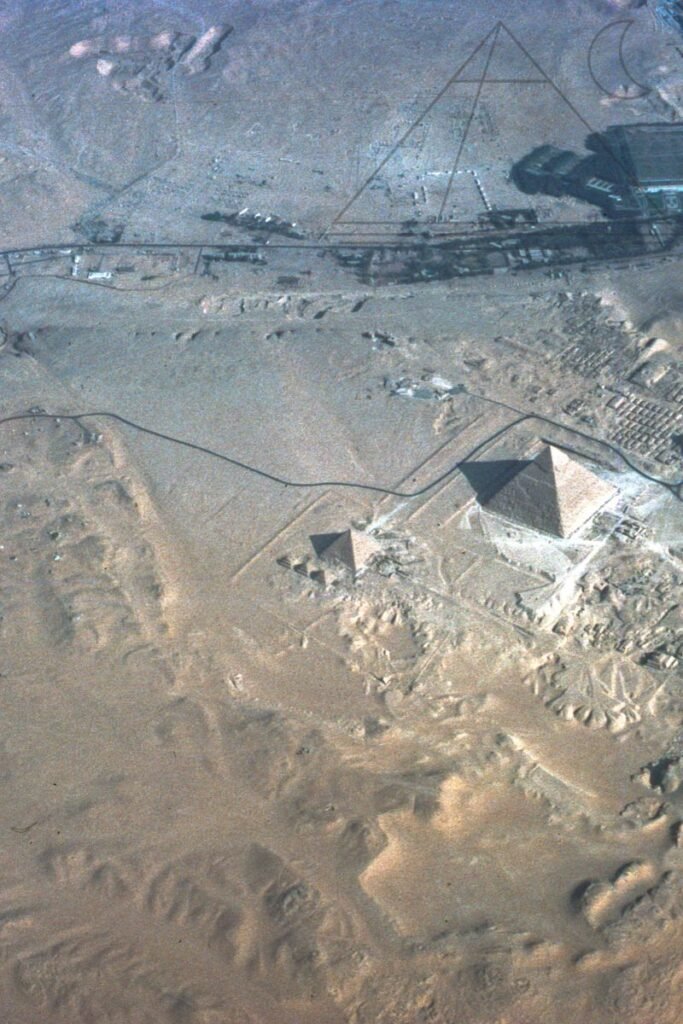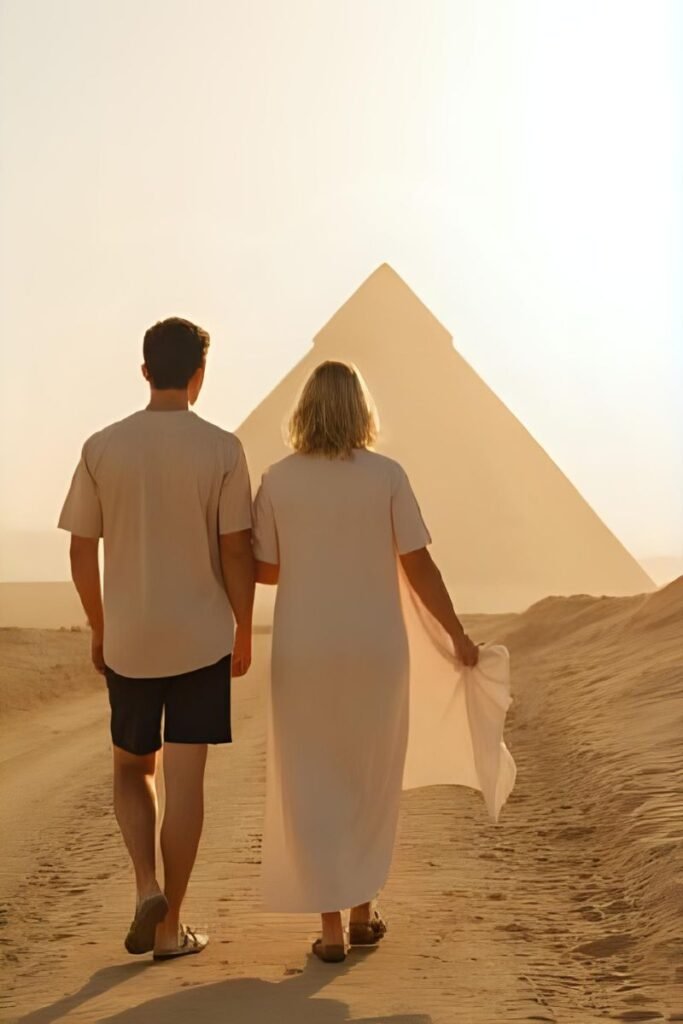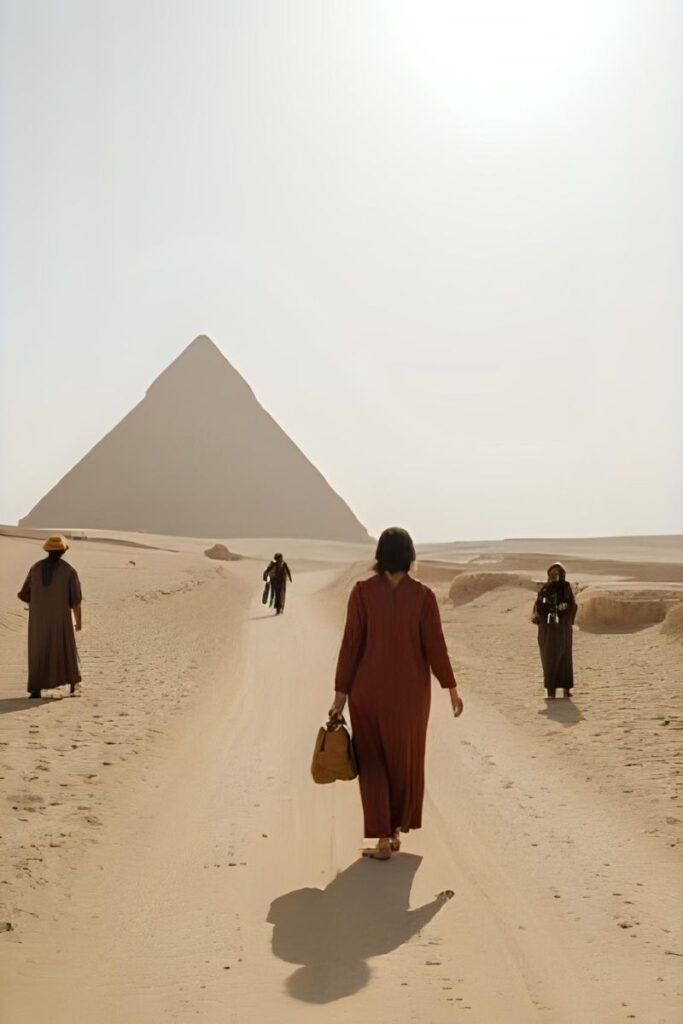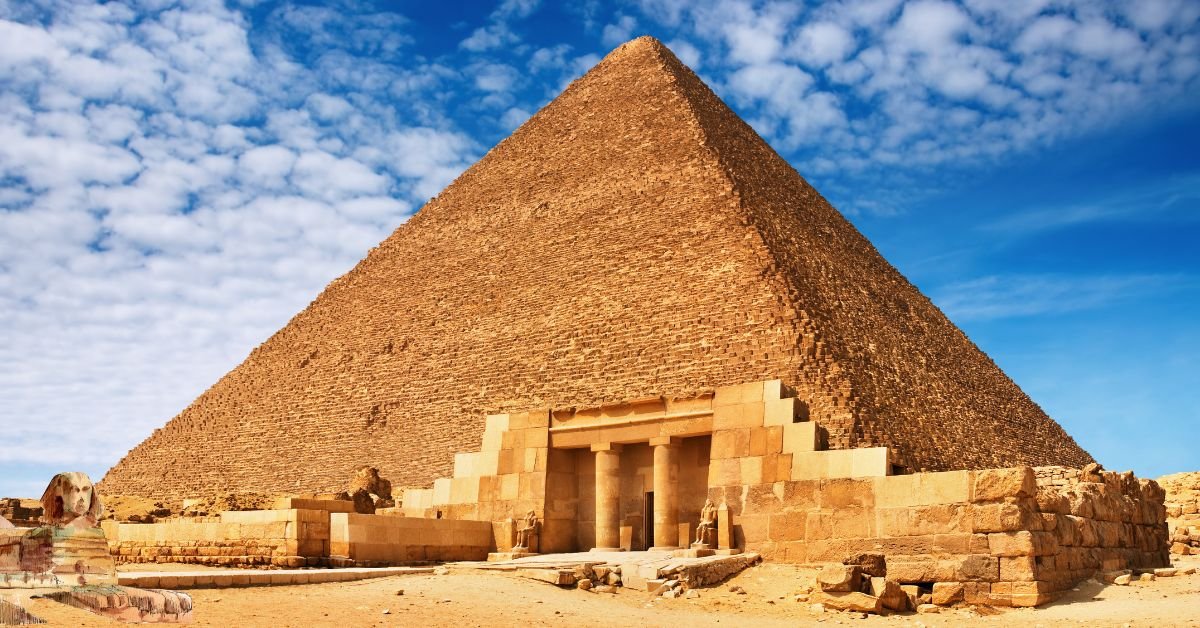A Pyramids Day Trip is a journey through time—but without the right plan, it can easily turn into a battle against crowds, heat, and missed wonders.
Egypt’s Giza Plateau needs no introduction. However, it is a home to the last surviving Ancient World Wonder, this legendary site just outside Cairo isn’t just a cluster of ancient stones, but a breathtaking testament to human ambition, engineering genius, and a legacy that still leaves visitors in awe.
Yet, visiting the Pyramids of Giza unprepared can allow your frustration creeps in. The midday sun scorches, ticket lines stretch endlessly, vendors swarm, and key experiences slip away.
But imagine this instead: exploring at your own pace, standing before the Great Pyramid as dawn paints it gold, and hearing the whispers of history in every weathered block—without rush, hassle, or regret.
This guide cuts through the chaos. You’ll get clear, practical steps to plan your Pyramids day trip with confidence, from avoiding crowds to unlocking the site’s deepest stories.
Ready for a stress-free, and unforgettable encounter with the Pyramids? Let’s begin.
Choose the Best Time to Visit
Your Pyramids day trip success hinges on one crucial decision: when you go. Time it right, and you’ll explore in cooler temps with fewer crowds. Get it wrong, and you’ll battle scorching heat and packed walkways. Here’s how to pick the perfect moment.
Avoid the Furnace
This is between April through to October. The daytime temperatures at Giza regularly soar above 35°C (95°F), and the pale limestone magnifies the glare. Even in winter, midday sun feels intense.
Golden Hours Rule
Early Morning (8 AM arrival):
- Cooler temps (20–25°C)
- Small crowds
- Perfect soft light for photos
- Peaceful exploration before the heat kicks in
Late Afternoon (Before Closing):
- Dramatic golden light on the pyramids
- Fewer tour groups (but winter hours may shorten access)
Pro Tip: Check seasonal closing times (Giza Plateau GPS: 29.9792, 31.1342). Skip Fridays if possible—the Muslim holy day draws larger local crowds.
Know What to Expect at the Giza Complex

Your pyramids day trip is more than just seeing the Great Pyramid – you’re entering a 4,500-year-old royal necropolis.
Here’s what awaits you:
The Iconic Trio: Three Pyramids That Tell a Story
1. The Great Pyramid of Khufu
The last surviving Ancient Wonder of the World
It is 146m tall, now stands at 138m
Inside experience: With an extra ticket, you can enter the narrow, humid burial chambers (not recommended for claustrophobic visitors)
Pro Tip: The interior has an unforgettable ancient atmosphere but involves crouching through tight passages
2. Pyramid of Khafre
Appears tallest due to its elevated base
Unique feature: Still has some original white limestone casing at the top
Best viewed from the panorama point for classic pyramid photos
3. Pyramid of Menkaure
The smallest but most intricate of the three
Notice the distinctive red granite casing stones at the base
Often the quietest, offering more peaceful exploration
4. The Legendary Sphinx
The world’s most famous statue: part lion, part pharaoh (believed to be Khafre)
Best photo spots: From the front in morning light or side angles at sunset
Important: Stay behind ropes – touching or climbing is strictly prohibited
Bonus Sites (When Available):
- Solar Boat Museum: Houses an incredible reconstructed funerary boat (check for reopening updates)
- Panoramic Viewpoint: Don’t miss the classic view of all three pyramids together
Enhance Your Experience:
I have always suggest to friends that it is a great idea to spend about 30 minutes before your trip, either watching a documentary or reading about Old Kingdom Egypt.
Knowing why these structures were built will make every carving and chamber ten times more meaningful. This will really help and enhance your experience before your trip.
Practical Notes:
- GPS coordinates for navigation: 29.9792° N, 31.1342° E
- Always verify current ticket prices and site openings on arrival
- Consider hiring a guide near the entrance for deeper insights (negotiate price first)
Book a Guided Tour for Maximum Value
Here is the big question, can you explore the Pyramids independently? Absolutely. But should you? That will now depends on how much you want to learn.
Booking a guided Giza Pyramids tour with an Egyptologist isn’t a tourist trap too, it’s also an educational investment.
A good guide doesn’t just rattle off dates; they animate the dynastic rivalries, engineering challenges, and religious significance with genuine storytelling.
Many travelers praise tours like the “Grand Egyptian Museum, Pyramids, Sphinx Tour & Lunch” from GetYourGuide for a reason:
- Hotel pickup and return in air-conditioned transport
- Pre-bought tickets (skip the ticket queue)
- Knowledgeable guide with academic or local credentials
- Lunch in a vetted, hygienic restaurant
Pro Tip: Always double-check what’s included. Because the interior pyramid entry usually costs extra, even when it is on a guided tours.
Tour operators often keep groups small, making it easier to ask questions, adjust the pace, and snap unhurried photos. Plus, local drivers know how to dodge the worst Cairo traffic.
By investing in a proper guided experience, you’re not only buying convenience but also cultural respect. Egyptians appreciate visitors who genuinely want to learn.
What to Wear to the Pyramids: Dress Smartly for Comfort and Respect

Dressing right for your Pyramids visit makes all the difference between a comfortable adventure and a sweaty struggle. Here’s how to stay cool, respectful, and ready for anything:
The Golden Rules of Pyramid Fashion:
1. Fabric is a Great Choice
- Go for: Lightweight cotton, breathable linen, or moisture-wicking fabrics
- Avoid: Dark colors (heat magnets) and synthetic materials that don’t breathe
2. Sun Protection Essentials
- Wide-brimmed hat (your future self will thank you)
- Quality sunglasses (the limestone glare is real)
- High SPF sunscreen (reapply every 2 hours)
- Light scarf (doubles as sun protection and modesty cover)
3. Shoes That Can Handle History
- Closed-toe with good grip (think hiking sandals or sneakers)
- Avoid flip-flops (hot sand + uneven terrain = blisters waiting to happen)
- Pro tip: Break in new shoes before your trip
Cultural Considerations That Actually Help You:
While Egypt doesn’t enforce strict dress codes for tourists, dressing modestly:
- Shows respect for local customs
- Reduces unwanted attention
- Actually keeps you cooler (less sun on your skin)
What Works Best:
- Men: Light pants + polo or breathable shirt
- Women: Maxi dress/skirt or loose pants with a lightweight top
- Everyone: Bring layers – mornings can be cool even when days get hot
Don’t Forget:
A small backpack to carry:
✓ Refillable water bottle
✓ Extra sunscreen
✓ Light jacket (for early mornings/windy moments)
Remember: You’ll be walking on ancient ground in modern sunlight. Dress for success, and you’ll focus on the wonders around you – not your sweaty back!
Modest dress is also important. As you know Egypt is culturally conservative. While no one expects tourists to wear a galabeya, it’s respectful to keep knees and shoulders covered outside of beach resorts.
Many travelers note they feel more comfortable, and less hassled by vendors, when dressed modestly.
Pack the Essentials for Your Pyramids Day Trip
You don’t need to lug a giant backpack through the desert, but a few essentials will vastly improve your experience:
- Refillable water bottle: Plastic waste is a problem in Egypt. Fill up at your hotel or in town.
- Snacks or light breakfast: Some tours leave early. Bring something portable if your hotel doesn’t pack a breakfast box.
- Camera or smartphone with extra battery: Photos eat power fast in the heat.
- Sunglasses and sunscreen: Absolute musts.
- Passport or ID: Security checks are routine, especially at ticket gates.
- Egyptian pounds in cash: For tips, extra tickets, camel rides, or small souvenirs. Card acceptance is limited at the site.
Pro Tip: Avoid flashy jewelry or big wads of cash. Pickpocketing is rare but not impossible in crowded areas.
Camel or Horse Ride for Iconic Photos
It might seem cliché, but a camel ride at the Pyramids is an undeniably classic experience. The trick? Doing it on your own terms.
Camel drivers at Giza have a reputation for hard bargaining. Always agree on a price before mounting. Typical short rides to panoramic viewpoints cost around 100–300 EGP (~3–10 USD), but guides can help negotiate fair rates.
Best photo spots:
- The southern panoramic viewpoint (GPS: 29.9721, 31.1301) has sweeping views of all three pyramids lined up.
- Near the Sphinx for the classic camel-and-monument shot.
- Prefer a smoother ride? Horses are available too. They’re often gentler on the back, especially if you’re not used to riding.
- Ethical note: Look for well-treated animals. Some stables are known for better animal welfare. Ask your guide for recommendations.
How to Visit the Pyramids Respectfully (A Traveler’s Responsibility)
Visiting the Pyramids is a great experience, and these monuments have stood for about 4,500 years. So we have a responsibility to play even why we visit, is to ensure they survive for future generations. Here’s how to explore them without causing harm or offense:
The Do’s & Don’ts of Pyramid Etiquette
✅ DO:
- Admire from a distance – No climbing, sitting, or leaning on the ancient stones.
- Follow photography rules – Outdoor shots are fine, but check for bans inside tombs (some areas prohibit flash or cameras entirely).
- Pack out your trash – Bring a small bag for waste (bins can be scarce).
- Dress & behave modestly – Shoulders/knees covered, and keep voices respectful.
❌ DON’T:
- Touch carvings or hieroglyphs – Skin oils degrade ancient surfaces over time.
- Deface anything (even “small” scratches) – Vandalism is a crime here.
- Ignore guards’ instructions – They’re protecting history, not ruining your fun.
- Assume rules don’t apply to you – This isn’t a theme park; it’s a UNESCO World Heritage Site.
Why It Matters
Egyptians take immense pride in their heritage—treat it with the same respect. A little courtesy goes a long way:
- Guards and locals will be more helpful if you’re polite.
- You’ll avoid fines, scoldings, or even expulsion from the site.
- Future travelers deserve to see the Pyramids as you did—untouched and awe-inspiring.
Leave nothing but footprints, take nothing but photos. The Pyramids have survived millennia—let’s keep them standing for millennia more.
Respect extends beyond the ruins. Dress appropriately as we mention earlier, speak politely to guards, and follow posted guidelines.
You’re a guest in Egypt—and Egyptians are famously welcoming when treated with courtesy.
Watch for Extra Costs
Many travelers assume their Giza ticket gets them everywhere. Not quite.
Your base ticket (prices can change, but typically 200–300 EGP) includes entry to the Giza Plateau and outdoor areas around the pyramids and Sphinx.
- Interior access to the pyramids is extra.
- Great Pyramid of Khufu: ~400–500 EGP
- Khafre and Menkaure: lower fees but similar access
- Entry is limited to a set number of visitors per day. If you want to go inside, buy tickets early—especially in peak tourist seasons.
Other extras:
- Camel or horse rides
- Tips for guides, drivers, and guards
- Souvenirs from local vendors
Bring small bills in Egyptian pounds. Card acceptance is improving but still spotty, especially with independent vendors.
How to Handle Vendors at the Pyramids (Without Losing Your Cool)

Yes, you have to take this seriously the vendors at Giza can test even the most patient traveler. You’ll hear “Special price for you, my friend!” about a hundred times before lunch. But here’s how to navigate it like a pro:
What to Expect:
- The sales pitch symphony: water, scarves, cheap souvenirs, camel rides
- The “free gift” that suddenly isn’t free
- “Best photo spot” offers (hint: they all say that)
Proven Strategies That Work:
1. The Polite Shield
Master these Arabic phrases:
- “La, shukran” (No, thank you)
- “Mafeesh fuloos” (I have no money)
- Say it with a smile but keep walking – hesitation invites persistence.
2. The Price Rule
- If you do want something:
Agree on exact price BEFORE touching anything - Pay only when you have the item in hand
- Have small bills ready (no “I don’t have change” games)
3. The Guide Advantage
A good local guide is worth their weight in gold here. Vendors back off when they see you’re with a professional.
Real Talk:
That “free” camel ride? There’s always a catch. That “special ancient artifact”? Made last week. Stay firm but friendly – most vendors are just trying to make a living in a tough economy.
Bonus Tip: Wear sunglasses – it helps avoid accidental eye contact that can be mistaken for interest. And remember, after the fifth “No thank you,” the sixth gets easier!
Extend Your Adventure Beyond Giza (If Time Allows)
You can make it even make your Pyramids day trip, even richer experience by exploring these nearby archaeological gems. Each site offers unique perspectives on ancient Egyptian engineering and culture.
Must-See Extensions:
1. Solar Boat Museum
Houses Khufu’s magnificent 4,500-year-old funerary boat
Currently being relocated to the Grand Egyptian Museum (verify status before visiting)
Pro Tip: Check with your guide about current accessibility
2. Saqqara (30km South of Giza)
GPS: 29.8711° N, 31.2164° E
Home to the Step Pyramid of Djoser (world’s oldest stone pyramid)
Advantages over Giza:
✓ Fewer crowds
✓ More relaxed atmosphere
✓ Active archaeological digs you can often observe
Don’t miss: The stunning hieroglyphs in nearby tombs
3. Dahshur (40km South of Giza)
GPS: 29.8065° N, 31.2055° E
Where pyramid engineering evolved:
- The Bent Pyramid (showing design experiments)
- The Red Pyramid (first true smooth-sided pyramid)
Major advantage: You’ll often have these sites virtually to yourself
Make Your Egyptian Adventure Unforgettable
With smart planning, your Pyramids Day Trip can becomes a transformative journey.
Here’s how to make it count:
Your Action Plan:
1.Time it right – Early mornings beat crowds and heat
2.Pack smart – Sun protection, water, comfortable shoes
3.Learn before you go – Even 30 minutes of reading enriches the experience
4.Consider a guide – Brings the stones to life with stories
5.Extend if possible – Saqqara and Dahshur complete the pyramid story
Ready to Experience Ancient Egypt?
This isn’t just sightseeing – it’s standing where pharaohs walked and marveling at what humans achieved millennia before modern technology. The pyramids have waited 4,500 years for your visit. Make it extraordinary.
Next Steps:
- Choose your ideal dates
- Book a knowledgeable guide
- Prepare with basic historical context
- Pack your sense of wonder
Your day among these ancient wonders might just change how you see human potential forever. When will your pyramid story begin?
Read Other Articles:




